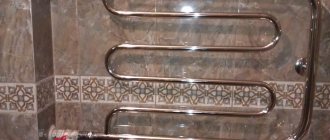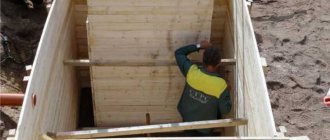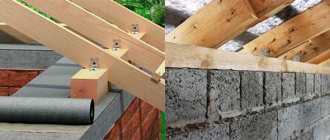The kitchen is an important room in an apartment or house, so it should have everything to ensure a comfortable cooking process. First of all, it is worth considering the arrangement of a gas stove and hood. The hood is of particular importance: it will eliminate all odors, as well as the settling of fat, fumes, and juices formed during cooking. Its normal functioning depends on the connection, for this reason it is important to know how to properly connect the hood to the ventilation in the kitchen. If you follow all the steps during this process, then in the future unpleasant odors will not spread to the entire room.
Hood integrated into ventilation
How natural ventilation works
Natural ventilation in our apartments is designed in such a way that air flows can freely flow from one room to another, moving from an area of high pressure to an area of lower pressure, i.e. from warm to cold. One air comes out, and another comes in its place. This is physics or the law of nature, and we are powerless against it.
With the advent of beautiful and sealed plastic windows in our homes, as well as metal doors with high-quality seals, fresh air cannot enter the apartments and natural air movement or air exchange stops. There is no more fresh air in the homes, the apartment is stuffy and high humidity. And then our man comes up with an additional problem - installing exhaust fans and “umbrellas” over kitchen stoves.
Common mistakes
The most common mistakes are made when installing corrugated or plastic air ducts. Thus, to install a plastic or corrugated pipe, it is important that its cross-section matches or exceeds in size the area of the air purifier outlet pipe. When purchasing hoses and exhaust equipment, you should pay attention to this.
The corrugated pipe must be installed as stretched as possible, which is not always observed. Its bends should not be less than the diameter of the corrugation itself.
When laying a plastic pipeline, the bend angles must be obtuse.
Basic principles of organizing ventilation in the kitchen
Modern residential buildings are equipped with a built-in ventilation system. It works due to the difference in densities of warm air in the room and cold air inside. For ventilation of an ordinary living space, a well-designed and properly constructed natural hood is quite sufficient, but in conditions of active cooking its efficiency will be low. To protect yourself from such problems, you need to solve two key problems:
- install an exhaust ventilation system in the kitchen;
- ensure a steady flow of fresh air.
There is a very important principle in medicine - do no harm. The same applies to repair and construction work. If, without understanding the design features of ventilation systems, you start rebuilding them, you can get a diametrically opposite result.
Very often, residents of apartment buildings try to expand the kitchen space by demolishing or moving existing ventilation ducts. As a result, it may turn out that with such a reconstruction it will not be possible to make a high-quality hood, and the atmosphere of the room will begin to fill with the aromas of your own or a neighbor’s toilet. The second problem why kitchen ventilation may not work is cheap plastic windows.
Old wooden structures did not provide complete airtightness of the premises, so natural ventilation occurred through their cracks. Modern windows can completely block the flow of fresh air, which will certainly reduce the cost of heating such a room, but at the same time eliminate the possibility of ventilating it when closed.
Working exhaust ventilation will remove contaminated air from the kitchen, creating an area of low pressure. For this reason, air from neighboring rooms will rush into it, into which, in turn, flows from ventilation systems or the staircase will be drawn. As a result, the apartment will be filled with the aromas of common areas and neighboring apartments, which is unlikely to bring pleasure to anyone.
There are two basic rules:
- any unauthorized intervention in the natural ventilation system may lead to its failure;
- Kitchen window openings must be equipped with devices that provide fresh air.
Types of ventilation systems for the kitchen
Even the most advanced natural ventilation is not able to cope with the atmosphere of the kitchen, so it requires the use of additional systems that can intensify air exchange. Such devices are classified according to:
- installation method;
- operating principle.
Depending on which design is chosen, both the results obtained and the costs of creating an outflow of polluted air will differ. Vapors concentrated in the kitchen atmosphere contain a lot of fats, soot and other contaminants, which, if not removed, will settle on the furniture, quickly leading it to an unsightly state. The same can happen to newly completed renovations. You can install the hood either independently, using the instructions supplied with it, or with the involvement of specialists who will do this work, taking into account the characteristics of the ventilation system of a particular house.
Operation, care
The instructions say: change the aluminum grease filter every two months. We would venture to guess that the instructions in the original language contain something like renew, which is translated as updating. Rather, the grease filter should be washed once every two months, avoiding buying a new one. Otherwise, the device will become an expensive purchase; in a year, maintenance will consume three times more money than the cost of the unit. Check with the manufacturer. You can do it yourself after purchasing. Just try to wash the grease filter, if the accessory returns to its previous condition and becomes as good as new, quickly continue using it.
The carbon filter will have to be changed. The large size is not so alarming as the renewal period - 2 months. The manufacturer is not so cruel, he specifies a period of six months, since the carbon filter costs money. The instructions say: regenerating or washing components is unacceptable. More like the truth. The carbon filter is located above the grease filter and is used in the recirculation mode, when the air simply circulates around. Not the best option for a gas stove; for an electric one, nothing more is needed.
Annoying: the name and type of carbon filter are not indicated. A direct search engine query regarding the type of kitchen hood in question is powerless to give a positive result. Cunning dealers are annoying when they write: the Hansa FWU 60 carbon filter is not available, but can be ordered. The price is kept silent. We find it difficult to calculate the cost of operating the product and have no desire to call to make inquiries. The reader will have to take the steering wheel. In this review we consider the installation of a kitchen hood, not the problems of stubbornness.
The components cost 250-800 rubles. Manufacturers identified. Avoid buying something for free and take a kitchen hood. Expensive carbon filters can last six months, cheap ones - two months. A simple calculation shows: we exchange the awl for soap. After a year, the cost of the product will be covered. An expensive kitchen hood, of high quality, requires similar operating costs.
Installation of a kitchen hood is carried out according to the instructions. Manufacturers' settings are specific, so don't think that kitchen hoods are alike, like twin brothers. All that remains is to say goodbye.
Differences between ventilation and exhaust systems
Many people confuse ventilation with exhaust hood, naively believing that they are the same thing. That by installing an exhaust dome over the stove without a fan and connecting it with an air duct to the standard duct of the ventilation unit, you will get two in one - both ventilation and exhaust. Will this type of ventilation work? Of course not.
Firstly, the main opening of the ventilation duct is blocked with an air duct. Secondly, the hood dome will be located approximately in the middle of the kitchen height, which significantly reduces the effectiveness of natural ventilation. Thirdly, such a system without a fan is absolutely useless and is not able to cope with fumes, most of which, together with warm air, bypassing the exhaust dome, will rise to the ceiling.
There are two options that allow you to use both a ventilation system and an exhaust system at the same time. Complementing each other, they will create a comfortable microclimate in the kitchen:
- Using a circulation type hood.
- Installation of a flow hood with a check valve.
Natural air exchange in the kitchen of a private house
Natural ventilation in the kitchen of a private house experiences the same difficulties as in an apartment, and perhaps even greater, since a lot of mistakes are made, starting with the design process. It seems that there is a ventilation system in the house, but upon closer examination it simply does not work. Next, we will look at the main mistakes in the design and installation of a cottage ventilation system.
- Location of ventilation grilles. According to all rules, they must be at least 10cm. from the ceiling, since warm, exhaust air must exit through them, displaced by colder, supply air. But in practice, things are not so rosy: In many kitchens, the exhaust grilles are located much lower, and as a result, a stagnation zone is formed, which is located above the grille.
- To save money, in a private house, neighboring rooms are often equipped with one ventilation shaft. That is why air, and with it odors, can move from the kitchen to the room, and not through the ventilation shaft. From the point of view of sanitary and hygienic standards, this is wrong.
- Another common mistake in designing the natural ventilation of a private house is the insufficient height of the ventilation pipes. Due to the small pressure difference, such ventilation may not work.
The kitchen of a cottage must have a natural ventilation system, but in practice, most developers do not consider this necessary and install only forced ventilation that depends on electricity. There is no electricity, and the fans do not work; exhaust air masses are not removed. Very often it is the fireplace that causes the ventilation system to work incorrectly. When fuel burns, it burns oxygen and pumps air out of the ventilation ducts.
These are just the main mistakes that are made when designing the natural ventilation of a private house. But how can you make kitchen ventilation more efficient?
Effective DIY ventilation
If the ventilation in your house does not work or works poorly, then with some simple knowledge or following our advice, even an amateur can resuscitate it. To do this, you need to know the principles of air flow and a few basic rules.
- The kitchen is a room with intense air exchange. According to the standards, the air exchange in this room should be no less than 90m3/hour. Translated into a more understandable language, this means that in one hour 90 cubic meters of waste air masses should be removed from your kitchen. But according to the balance equation ∑ Lpr. = ∑ Lout, for sufficient air exchange an inflow of 90 m3/hour is needed.
Armed with knowledge, now to restore ventilation in the kitchen, you need to install an exhaust fan in the ventilation duct with a capacity of at least 90 m3/hour. But we remind you that this is only if the natural exhaust of air from this room does not work. Now you need to take care of the supply air. You can keep the kitchen windows open all year round, but we think this is not an option. For good air exchange, you can install supply valves in the wall that faces the street. As a rule, they are mounted behind a heating radiator and the incoming cold air masses are immediately heated. The main thing is to maintain a balance between the volume of supply and exhaust air.
The ventilation system of your home, carried out according to all the rules, will provide you with fresh and clean air, and will delight you with the absence of foreign odors and high energy efficiency.
Do-it-yourself pipe masking
You can install decorative boxes yourself, even without having great home craftsmanship skills. Here it is important to decide in advance on the pipe finishing option, select the right material and fasteners.
Required tools and materials
The following set of tools will be needed:
- electric drill;
- screwdriver;
- perforator;
- scissors for working with metal;
- for working with wood and drywall - a jigsaw;
- ruler;
- level.
For fastening you should purchase:
- dowels of the required size;
- self-tapping screws;
- metal profiles;
- mounting screws;
- clamps for fastening the air duct.
Before purchasing materials, you should determine the dimensions of the structure and calculate the volume of purchase.
Work progress
To hide the corrugation, a decorative box of plasterboard is most often constructed.
- Work begins with measuring the space and air duct, and sketching out the installation project.
- Using a ruler and level, mark with a pencil on the wall. Along the wall, and then along the ceiling, guide profiles are attached with dowels, then vertical sections are attached to them with self-tapping screws.
- The corrugated sleeve is fixed in the openings of the hood and ventilation shaft, placing it inside the frame.
- The frame is covered with plasterboard along the profiles using self-tapping screws.
- The manufactured box can be finished in accordance with the interior of the kitchen: painted, wallpapered, or used other materials.
Circulation type hoods
The principle of operation of these hoods is that they do not remove polluted air from the kitchen, but, thanks to the installed filters, clean it from small droplets of fat, moisture and odor. Essentially, this is a unit for collecting fat particles and filtering air. In this case, circulation and air change are provided by standard ventilation. This hood consists of such structural elements as:
- Frame.
- Electric fan.
- Grease catcher.
- Carbon filter.
The fan ensures a constant flow and passage of air through the filters. The first filter collects and retains fatty particles, the second (fine carbon filter) neutralizes odors and moisture. Dirty filters must be replaced and are fairly easy to change. The service life of the filters depends on the hood model, design and frequency of use.
Additional functions
Some models of modern exhaust fans cannot be called simple. Manufacturers, in pursuit of the client, equip them with a wide variety of additional options:
- filter mesh grease traps;
- human presence sensors;
- humidity controllers;
- programmable timers.
Decide for yourself whether you need such functions in a simple fan, but any additions increase the cost of electrical equipment and reduce the period of its trouble-free operation.
Types of suspension systems
Hanging systems are classified according to their location in the kitchen. This will determine how and where they will be attached. Among the suspended ventilation systems, the following varieties can be distinguished:
- wall;
- corner;
- island.
The first ones are the most common. They are made in a wide variety of design options, so it is easy to choose a product that matches the appearance of previously purchased furniture.
Island products can be placed anywhere in the room, as they are mounted to the ceiling. Such designs are often used in designer kitchen furniture.
New Design Trends
By hanging cabinets in rich colors, you can divert attention from the shortcomings of the room. To even out the area, choose floor coverings with a geometric pattern. To increase the size of the kitchen, you can connect it to the living room. More space will appear, the box will become less noticeable. If the structure is too large, then you should abandon design techniques for camouflage. It is better to divide the work surface into several sections.
The ventilation protrusion can be disguised in several ways. But most often, designers hide it under the elements of the kitchen set.
In this case, the furniture will be made to order, which, of course, will require large investments.
See alsoDesign of a kitchen-living room with an area of 16 square meters. m.
Built-in and suspended ventilation systems
A typical kitchen has a fairly standard set of furniture necessary for storing food and utensils. The exhaust ventilation system must fit into the interior created by these items, without taking up a lot of space, which is usually not enough in many older houses. Kitchen ventilation can be done:
- built into a wall cabinet or table;
- suspension.
The first ones easily fit into any interior and are especially good when the kitchen is made to order. There are many design projects that allow you to hide technical structural elements inside the furniture, so the presence of powerful exhaust ventilation in it can only be guessed after it is turned on.
Hanging products are the most popular and widespread. They can be purchased separately and installed in addition to existing kitchen furniture, but they can also be part of a set made to order for a specific interior of the room. Such structures are mounted above the stove and have a variety of designs and technical features.
Methods for masking pipes
Instead of corrugation, you can use a plastic pipe of round or rectangular cross-section, suitable in size for the diameter of the channel. To connect short sections, adapters of various configurations are used. The disadvantage of a plastic pipeline is the loss of traction when it is long. Therefore, it is recommended to use such a plastic box only if there is a ventilation hole next to the hood.
You can decorate a corrugated sleeve in the following ways.
- A box made of plasterboard. It is built on a frame made of metal profiles and then painted in a color that matches the design of the kitchen.
- Built-in furniture. The air duct is inconspicuously placed in the walls of a high wall cabinet suspended above the stove. This option is suitable in the case of a built-in hood mounted at the bottom of such a cabinet.
Both options can be combined with lighting made from LED elements, which will add comfort and brightness to the lighting in the kitchen.
- Cornice of a kitchen set. The exhaust pipe is passed close to the wall along the top of the kitchen furniture, and it becomes closed behind the cornice.
- Suspended or stretch ceiling. In this case, the corrugated pipe will be completely hidden. The ceiling height will lose from 13 to 15 cm.
- Decorative elements or painting of corrugation, which will act as an element of the kitchen interior.
If your kitchen is decorated in a high-tech style, the aluminum corrugation can be left as is, without masking. It goes well with this style.
How to properly organize a hood in a kitchen with a gas stove
Today, almost all kitchens in private houses and apartments are equipped with a hood, and this is a problem. The problem is not with the hood itself, but with the fact that the ventilation ducts are not always designed for its use. Standard air ducts in our homes have a cross-section of 130x130mm, and their maximum capacity is 180m3/h. But modern “umbrellas” have a power that exceeds the throughput by several times, and this has an extremely negative effect on the operation of the general building ventilation system, as well as the ventilation of your own apartment.
In order to properly organize the ventilation of a kitchen with a gas stove, you need to make it mixed, i.e. correctly combine the work of the exhaust “umbrella” and natural ventilation. This can be done in two ways.
- Connect the kitchen hood air duct to the air outlet duct, above the grille of the natural ventilation system. Moreover, the air duct should be directed into the shaft with an upward turn.
- The second method involves connecting the kitchen hood air duct above the natural ventilation hole, without tucking it into the shaft. But at the same time, the ventilation grille must be equipped with a check valve so that it closes the grille when the exhaust “umbrella” is operating.
Which way is better
The most rational camouflage option will be the one that best suits the interior of your kitchen.
The simplest way is to replace the corrugation with a plastic air duct. But we must take into account that it is effective only when the hood is located close to the ventilation hole. In addition, the plastic box must fit into the color design of the kitchen. Otherwise, it will have to be painted or covered with suitable wallpaper.
If the sleeve is long and extends across the entire room, then the best option would be a suspended ceiling that allows you to completely hide the exhaust pipe.
The cheapest option would be to paint the corrugation and decorate it with simple decorative elements.











